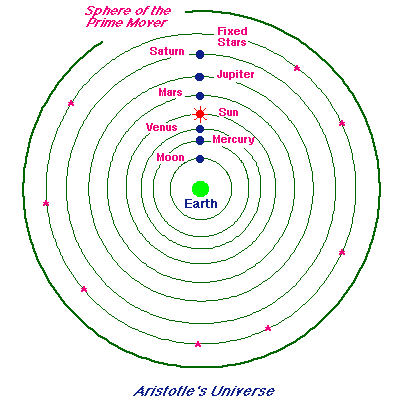
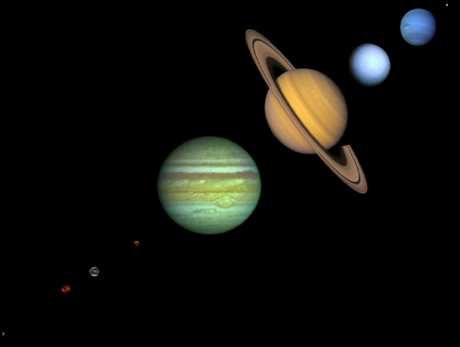 The Universe of
The Universe of
Although Aristotle was not a scientist, it is important to note that he did point out that the Earth had to be sphere since its shadow was always circular. This was in fact a key scientific insight. It allowed Eratosthenes around 200 BC to calculate the circumference of the Earth. The method was very clever for the time:
The southern Egyptian city of Syene had a well in which sun-rays fell directly vertical during the summer solstice. The sun was therefore at the Zenith there during this time.
However, during the same time in Alexandria, the sun was 7 degrees south of the Zenith (1/50 of the circumference of the sky). Now since the Earth was spherical (from Aristotle) the 7 degree angle subtended at the Earths surface divided by 360 degrees equaled the distance between Alexandria and Syene divided by the Earth's circumference. That is, by using
7 / 360 = distance / circumference
he could measure the distance (in units of stadia) and then infer the circumference in stadia (about 40,000). Hard to infer the actual distance in standard modern units since stadia are of varying sizes, but the technique was clever at the time and if one uses typical stadium lengths of the time the estimate was only off by a number bewteen 4 and 14 percent.

By adjusting the velocities of these concentric spheres, many features of
planetary motion could be explained. However, the troubling observations of
varying planetary brightness and retrograde motion could not be accommodated:
the spheres moved with constant angular velocity, and the objects
attached to them were always the same distance from the earth because they
moved on spheres with the earth at the center.
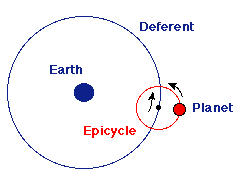 The "solution" to these problems came in the form of a clever
proposal: planets were attached, not to the concentric spheres themselves, but
to circles attached to the concentric spheres, as illustrated in the adjacent
diagram. These circles were called "Epicycles", and the concentric spheres to
which they were attached were termed the "Deferents". Then, the centers of the
epicycles executed uniform circular motion as they went around the deferent at
uniform angular velocity, and at the same time the epicycles (to which the
planets were attached) executed their own uniform circular motion.
The "solution" to these problems came in the form of a clever
proposal: planets were attached, not to the concentric spheres themselves, but
to circles attached to the concentric spheres, as illustrated in the adjacent
diagram. These circles were called "Epicycles", and the concentric spheres to
which they were attached were termed the "Deferents". Then, the centers of the
epicycles executed uniform circular motion as they went around the deferent at
uniform angular velocity, and at the same time the epicycles (to which the
planets were attached) executed their own uniform circular motion.
The net
effect was as illustrated in the following animation. As the center of the
epicycle moves around the deferent at constant angular velocity, the planet
moves around the epicycle, also at constant angular velocity. The apparent
position of the planet on the celestial sphere at each time is indicated by the
line drawn from the earth through the planet and projected onto the celestial
sphere. The resulting apparent path against the background stars is indicated
by the
blue line.
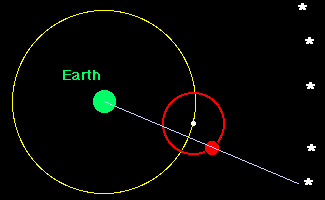
Now, in this tortured model one sees that it is possible to have retrograde
motion and varying brightness, since at times as viewed from the earth the
planet can appear to move "backward" on the celestial sphere. Obviously,
the distance
of the planet from the Earth also varies with time, which leads to variations
in brightness.
Thus, the idea of uniform
circular motion is saved (at least in some sense) by this scheme, and it allows
a description of retrograde motion and varying planetary brightness.
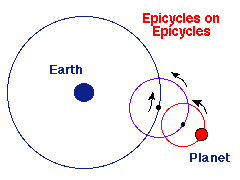 In practice, even this was not enough to account for the detailed
motion of the planets on the celestial sphere. In more sophisticated epicycle
models further "refinements" were introduced:
In practice, even this was not enough to account for the detailed
motion of the planets on the celestial sphere. In more sophisticated epicycle
models further "refinements" were introduced:
Thus, the ideas largely originating with pagan Greek philosophers were baptized into the Catholic church and eventually assumed the power of religious dogma: to challenge this view of the Universe was not merely a scientific issue; it became a theological one as well, and subjected dissenters to the considerable and not always benevolent power of the Church.